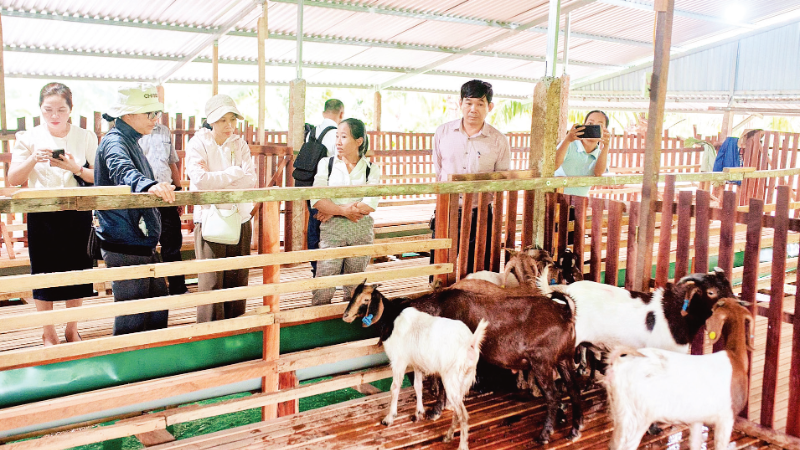Climate-adapted livestock sector linked to eco-tourism
Livestock farming in the South Central Coast and Central Highlands region is facing numerous difficulties due to drought and water shortages. Therefore, local farmers are transitioning to climate-adapted models linked to eco-tourism to sustain livelihoods and boost income.

According to the Department of Livestock Production and Animal Health under the Ministry of Agriculture and Environment, the region’s natural grassland and other advantages make it well-suited for developing livestock farming.
In recent years, livestock farming in these areas has expanded in scale, adopted new techniques to increase production, diversified products, and established linkages to enhance value and meet consumption demands.
By the end of 2024, the region had more than 2.46 million cattle, nearly 6 million pigs, over 75.3 million poultry and over 554,000 goats. Many localities are now shifting towards climate-adapted livestock farming linked to eco-tourism, bringing high economic efficiency.
Nguyen Van Huong, an official at the National Agricultural Extension Centre, said: “The National Agricultural Extension Centre is implementing six climate-adapted livestock farming projects linked to eco-tourism across the country. In Khanh Hoa Province, a breeding goat farming model linked to eco-tourism has been in place since 2023 with six participating households. Surveys show that the model’s economic efficiency has increased by about 23% compared to conventional methods.”
He added that “participating households not only raise goats but also grow timber and fruit trees, plant grass, improve hillside gardens and create an ecological environment to attract tourists. On average, households in the model attract 30-50 visitors per year, mainly foreign tourists.”
According to the Khanh Hoa Department of Agriculture and Environment, as of July 2025, the province had over 822,000 cattle and about 5.4 million poultry. To support the climate-adapted livestock sector, the province has introduced a range of incentives policies for investment in biosecure livestock farming, emission reduction, and water and energy conservation, with priority given to high-tech applications.
Notably, the province has integrated the development of tourism models linked to sheep, goat and ostrich farming in rural and mountainous areas, thereby creating livelihoods for local people, attracting tourists and enhancing product value.
In addition, training programmes and technical workshops on new techniques and community-based tourism have also been deployed to households. To date, many farms in the province has successfully applied the model.
Y Khen, a participant, has been trained in goat care, feed processing, and disease prevention and treatment measures, helping to reduce costs and improve product quality. His family currently raises 63 goats, cultivates 2 hectares of fruit trees, and operates a fish pond. Alongside income from selling goats, fruit and fish, the family also earns additional income from visitors each year.
Nevertheless, climate-adapted livestock farming linked to eco-tourism in the South Central Coast and Central Highlands still faces many challenges, including water shortages, drought, and soil erosion, which affect productivity and animal health, and lead to disease outbreaks.
Livestock farming remains small-scale and scattered, is not yet integrated into to eco-tourism spatial planning, and lacks systematic investment, management skills and market access. Many localities have natural resources and distinctive cultures but lack specific tourism products linked to livestock farming, as well as synchronised policies to support integrated livestock-tourism models.
Le Quoc Thanh, Director of the National Agricultural Extension Centre, noted that the impact of climate change on agriculture is increasingly apparent. Therefore, choosing climate-adapted livestock farming models linked to eco-tourism opens new opportunities and contributes to higher income for local residents.
However, to maximise effectiveness and attract tourists, models need to ensure environmental hygiene, and provide safe and high-quality products. Localities should also capitalise on their landscapes and cultural heritage to build unique models that draw visitors and create additional value for livestock farmers.
In the long term, it is necessary to adopt biosafe, organic and circular livestock farming models that reduce emissions and protect the environment; promote and introduce livestock farming models linked to eco-tourism; and develop experiential livestock farms tied to agricultural and ecological education.
Localities can also organise tours that allow visitors to explore clean production chains from animal care to processing and tasting specialities, design green, clean and friendly tourism spaces, and apply effective waste treatment technology to prevent environmental pollution and ensure eco-tourism development.
Additionally, stronger linkages are needed between cooperatives, enterprises and farmers on the one hand and travel agencies on the other. Production tied to eco-tourism should be supported in planned development areas to preserve cultural identity and promote rural economic growth.








